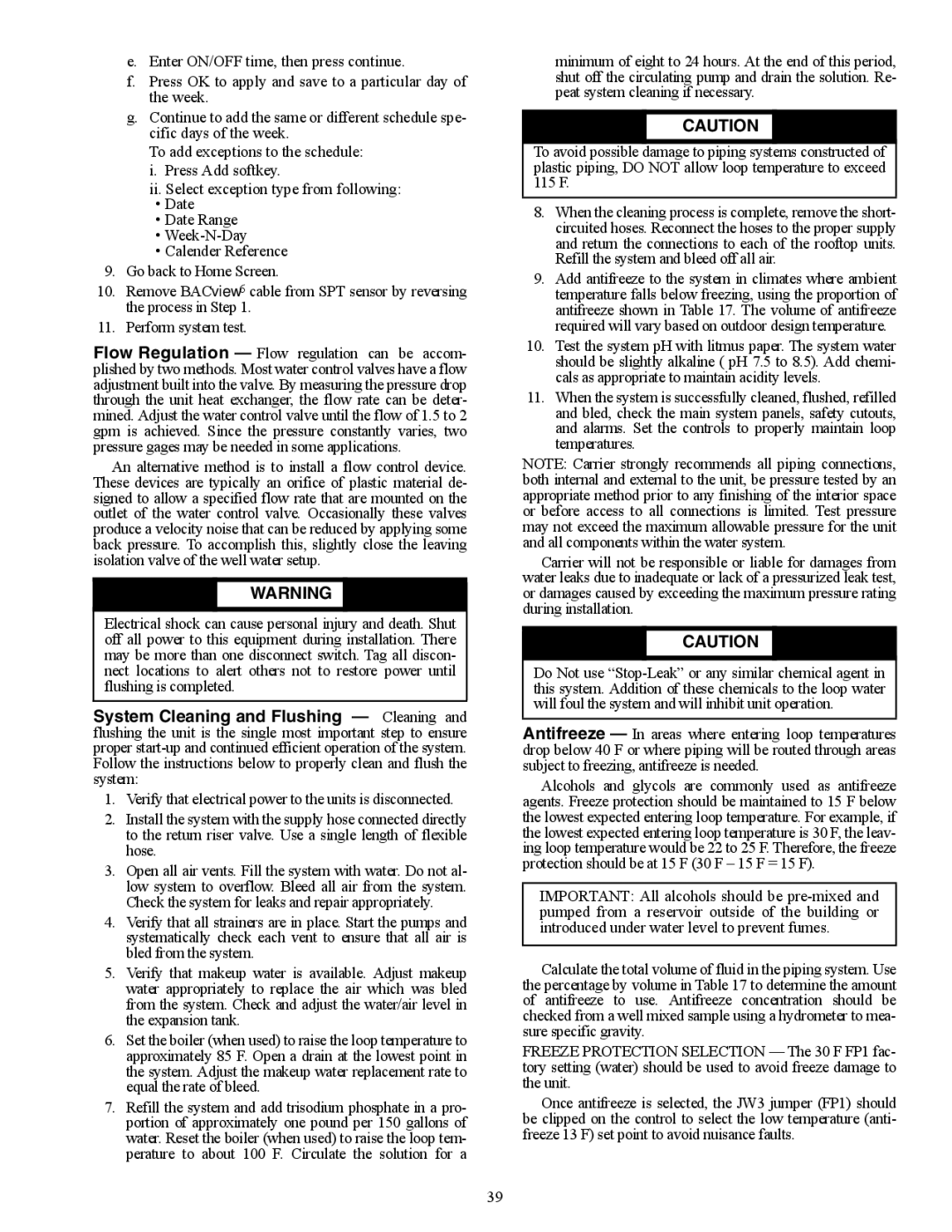
e.Enter ON/OFF time, then press continue.
f.Press OK to apply and save to a particular day of the week.
g.Continue to add the same or different schedule spe- cific days of the week.
To add exceptions to the schedule:
i.Press Add softkey.
ii.Select exception type from following:
•Date
•Date Range
•
•Calender Reference
9.Go back to Home Screen.
10.Remove BACview6 cable from SPT sensor by reversing the process in Step 1.
11.Perform system test.
Flow Regulation — Flow regulation can be accom- plished by two methods. Most water control valves have a flow adjustment built into the valve. By measuring the pressure drop through the unit heat exchanger, the flow rate can be deter- mined. Adjust the water control valve until the flow of 1.5 to 2 gpm is achieved. Since the pressure constantly varies, two pressure gages may be needed in some applications.
An alternative method is to install a flow control device. These devices are typically an orifice of plastic material de- signed to allow a specified flow rate that are mounted on the outlet of the water control valve. Occasionally these valves produce a velocity noise that can be reduced by applying some back pressure. To accomplish this, slightly close the leaving isolation valve of the well water setup.
![]() WARNING
WARNING
Electrical shock can cause personal injury and death. Shut off all power to this equipment during installation. There may be more than one disconnect switch. Tag all discon- nect locations to alert others not to restore power until flushing is completed.
System Cleaning and Flushing — Cleaning and flushing the unit is the single most important step to ensure proper
1.Verify that electrical power to the units is disconnected.
2.Install the system with the supply hose connected directly to the return riser valve. Use a single length of flexible hose.
3.Open all air vents. Fill the system with water. Do not al- low system to overflow. Bleed all air from the system. Check the system for leaks and repair appropriately.
4.Verify that all strainers are in place. Start the pumps and systematically check each vent to ensure that all air is bled from the system.
5.Verify that makeup water is available. Adjust makeup water appropriately to replace the air which was bled from the system. Check and adjust the water/air level in the expansion tank.
6.Set the boiler (when used) to raise the loop temperature to approximately 85 F. Open a drain at the lowest point in the system. Adjust the makeup water replacement rate to equal the rate of bleed.
7.Refill the system and add trisodium phosphate in a pro- portion of approximately one pound per 150 gallons of water. Reset the boiler (when used) to raise the loop tem- perature to about 100 F. Circulate the solution for a
minimum of eight to 24 hours. At the end of this period, shut off the circulating pump and drain the solution. Re- peat system cleaning if necessary.
![]() CAUTION
CAUTION
To avoid possible damage to piping systems constructed of plastic piping, DO NOT allow loop temperature to exceed 115 F.
8.When the cleaning process is complete, remove the short- circuited hoses. Reconnect the hoses to the proper supply and return the connections to each of the rooftop units. Refill the system and bleed off all air.
9.Add antifreeze to the system in climates where ambient temperature falls below freezing, using the proportion of antifreeze shown in Table 17. The volume of antifreeze required will vary based on outdoor design temperature.
10.Test the system pH with litmus paper. The system water should be slightly alkaline ( pH 7.5 to 8.5). Add chemi- cals as appropriate to maintain acidity levels.
11.When the system is successfully cleaned, flushed, refilled and bled, check the main system panels, safety cutouts, and alarms. Set the controls to properly maintain loop temperatures.
NOTE: Carrier strongly recommends all piping connections, both internal and external to the unit, be pressure tested by an appropriate method prior to any finishing of the interior space or before access to all connections is limited. Test pressure may not exceed the maximum allowable pressure for the unit and all components within the water system.
Carrier will not be responsible or liable for damages from water leaks due to inadequate or lack of a pressurized leak test, or damages caused by exceeding the maximum pressure rating during installation.
![]() CAUTION
CAUTION
Do Not use
Antifreeze — In areas where entering loop temperatures drop below 40 F or where piping will be routed through areas subject to freezing, antifreeze is needed.
Alcohols and glycols are commonly used as antifreeze agents. Freeze protection should be maintained to 15 F below the lowest expected entering loop temperature. For example, if the lowest expected entering loop temperature is 30 F, the leav- ing loop temperature would be 22 to 25 F. Therefore, the freeze protection should be at 15 F (30 F – 15 F = 15 F).
IMPORTANT: All alcohols should be
Calculate the total volume of fluid in the piping system. Use the percentage by volume in Table 17 to determine the amount of antifreeze to use. Antifreeze concentration should be checked from a well mixed sample using a hydrometer to mea- sure specific gravity.
FREEZE PROTECTION SELECTION — The 30 F FP1 fac- tory setting (water) should be used to avoid freeze damage to the unit.
Once antifreeze is selected, the JW3 jumper (FP1) should be clipped on the control to select the low temperature (anti- freeze 13 F) set point to avoid nuisance faults.
39
